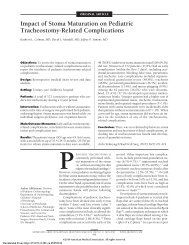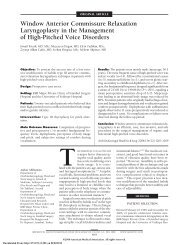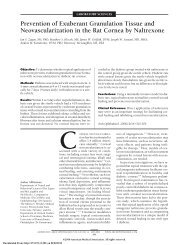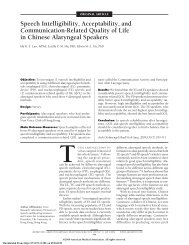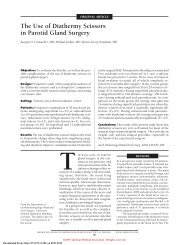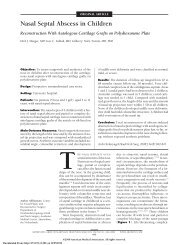Henry “Jullundur” Smith's “Extraction of Cataract in the Capsule”
Henry “Jullundur” Smith's “Extraction of Cataract in the Capsule”
Henry “Jullundur” Smith's “Extraction of Cataract in the Capsule”
Create successful ePaper yourself
Turn your PDF publications into a flip-book with our unique Google optimized e-Paper software.
SPECIAL ARTICLE<br />
<strong>Henry</strong> <strong>“Jullundur”</strong> Smith’s<br />
<strong>“Extraction</strong> <strong>of</strong> <strong>Cataract</strong> <strong>in</strong> <strong>the</strong> <strong>Capsule”</strong><br />
A Landmark Article<br />
James G. Rav<strong>in</strong>, MD<br />
Acentury ago, <strong>the</strong> ARCHIVES published an important paper by <strong>Henry</strong> <strong>“Jullundur”</strong> Smith,<br />
MD (1859-1948), <strong>“Extraction</strong> <strong>of</strong> cataract <strong>in</strong> <strong>the</strong> capsule.” 1 At that time, most cataract<br />
surgeons <strong>in</strong>cised <strong>the</strong> anterior lens capsule and removed <strong>the</strong> nucleus, leav<strong>in</strong>g <strong>the</strong> posterior<br />
capsule beh<strong>in</strong>d. Many complications were known to be less severe when <strong>the</strong><br />
posterior capsule rema<strong>in</strong>ed <strong>in</strong>tact. Unfortunately, however, <strong>the</strong> capsule became opaque postoperatively<br />
<strong>in</strong> nearly every case <strong>of</strong> an immature cataract because <strong>the</strong>re was no good method <strong>of</strong> remov<strong>in</strong>g<br />
cortical material from <strong>the</strong> posterior capsule.<br />
Author Affiliations: Medical College <strong>of</strong> Ohio, Toledo.<br />
F<strong>in</strong>ancial Disclosure: None.<br />
When Hermann Knapp, MD (1832-1911),<br />
<strong>the</strong> editor <strong>of</strong> <strong>the</strong> ARCHIVES, accepted Smith’s<br />
article for publication, he wrote Smith, “If<br />
you can establish a safe method <strong>of</strong> <strong>in</strong>tracapsular<br />
extraction <strong>of</strong> cataract, you will<br />
be a greater benefactor to mank<strong>in</strong>d than<br />
Daviel.” 2 Debatably, <strong>the</strong> most important<br />
date <strong>in</strong> <strong>the</strong> history <strong>of</strong> ophthalmic surgery is<br />
April 8, 1747, when Jacques Daviel (1696-<br />
1792) performed <strong>the</strong> first planned extracapsular<br />
cataract extraction. 3 His operation<br />
was done <strong>in</strong> 4 steps: a corneal <strong>in</strong>cision,<br />
an anterior capsulectomy, expression <strong>of</strong> <strong>the</strong><br />
nucleus, and cortical removal us<strong>in</strong>g a curette.<br />
This process was a major improvement<br />
on <strong>the</strong> earlier method <strong>of</strong> couch<strong>in</strong>g <strong>the</strong><br />
lens <strong>in</strong>to <strong>the</strong> vitreous. On occasion, he<br />
would do an <strong>in</strong>tracapsular extraction, if <strong>the</strong><br />
whole lens happened to come out by expression.<br />
The credit for be<strong>in</strong>g <strong>the</strong> first to remove<br />
an <strong>in</strong>tact cataractous lens through a<br />
corneal <strong>in</strong>cision goes to ano<strong>the</strong>r Frenchman,<br />
Charles de Sa<strong>in</strong>t-Yves (1667-1733). He<br />
removed at least one lens that had been traumatically<br />
displaced <strong>in</strong>to <strong>the</strong> anterior chamber,<br />
possibly when faced with a failed couch<strong>in</strong>g<br />
procedure that left <strong>the</strong> cataract still<br />
block<strong>in</strong>g most <strong>of</strong> <strong>the</strong> pupil. 4<br />
Smith said Knapp’s comment “was <strong>the</strong><br />
first word <strong>of</strong> encouragement I had received<br />
from any ophthalmologist <strong>of</strong> stand<strong>in</strong>g.”<br />
2 More typical was <strong>the</strong> comment <strong>of</strong><br />
(REPRINTED) ARCH OPHTHALMOL / VOL 123, APR 2005 WWW.ARCHOPHTHALMOL.COM<br />
544<br />
©2005 American Medical Association. All rights reserved.<br />
Downloaded From: http://173.193.11.201/ on 04/09/2013<br />
<strong>the</strong> president <strong>of</strong> <strong>the</strong> ophthalmological section<br />
<strong>of</strong> <strong>the</strong> British Medical Association at<br />
its annual meet<strong>in</strong>g <strong>in</strong> 1903: “I believe <strong>the</strong>re<br />
is a deep-rooted opposition to this procedure.”<br />
2 The <strong>in</strong>cidence <strong>of</strong> vitreous loss was<br />
just too high for most surgeons to be will<strong>in</strong>g<br />
to undertake <strong>in</strong>tracapsular surgery.<br />
<strong>Henry</strong> Smith (Figure 1) was born <strong>in</strong> Ireland<br />
and educated at Queen’s College, Galway,<br />
and <strong>the</strong> Royal University <strong>of</strong> Ireland. He<br />
served for 30 years <strong>in</strong> <strong>the</strong> Indian Medical Service,<br />
ma<strong>in</strong>ly <strong>in</strong> Jullundur and Amritsar, and<br />
achieved <strong>the</strong> military rank <strong>of</strong> lieutenant colonel.<br />
He was not just an ophthalmic surgeon<br />
but also handled a wide variety <strong>of</strong> general<br />
surgical cases. <strong>Cataract</strong> patients came<br />
to his hospital <strong>in</strong> <strong>the</strong> spr<strong>in</strong>g and late fall, depend<strong>in</strong>g<br />
on <strong>the</strong> climate. He is remembered<br />
for be<strong>in</strong>g a fearless surgeon who worked and<br />
even operated while smok<strong>in</strong>g a cigar<br />
(Figure 2). He once told a colleague, “If I<br />
have to lay down my cheroot, Harvey, it is<br />
a bad operation, and if my cheroot goes out,<br />
it is a damned bad operation.” 5<br />
In 1905, Smith was by far <strong>the</strong> most experienced<br />
cataract surgeon <strong>the</strong> world had<br />
ever known. He had performed more than<br />
11000 procedures, 2000 by <strong>the</strong> orthodox<br />
extracapsular method and more than 9000<br />
<strong>in</strong>tracapsularly. (By 1921, he had done<br />
50000 cataract operations.) In his 1905<br />
ARCHIVES article, Smith reported <strong>the</strong> results<br />
<strong>of</strong> 2616 <strong>in</strong>tracapsular cases done<br />
between May 1904 and May 1905. His complications<br />
<strong>in</strong>cluded 0.3% iritis, 6.8% vitre-
Figure 1. Lt Col <strong>Henry</strong> Smith <strong>in</strong> formal military attire. 5 Figure 2. Smith exam<strong>in</strong><strong>in</strong>g a patient while smok<strong>in</strong>g a cigar. 6<br />
ous loss, and 8% capsular rupture.<br />
He considered only 0.34% <strong>of</strong> his<br />
cases failures. Smith felt <strong>the</strong> advantages<br />
<strong>of</strong> <strong>in</strong>tracapsular surgery were<br />
<strong>the</strong> lack <strong>of</strong> an opaque capsule postoperatively,<br />
far less iritis, better visual<br />
acuity, fewer <strong>in</strong>fections, and<br />
comparable rates <strong>of</strong> vitreous loss.<br />
Smith used topical coca<strong>in</strong>e as anes<strong>the</strong>sia<br />
and stressed <strong>the</strong> importance<br />
<strong>of</strong> controll<strong>in</strong>g <strong>the</strong> orbicularis<br />
oculi muscle to prevent <strong>the</strong> patient<br />
from squeez<strong>in</strong>g. He would <strong>in</strong>sert<br />
a speculum and make a “liberalsized”<br />
knife <strong>in</strong>cision superiorly. He<br />
<strong>the</strong>n removed <strong>the</strong> speculum, and an<br />
assistant would elevate <strong>the</strong> upper lid<br />
with a strabismus hook and retract<br />
<strong>the</strong> lower lid with a thumb. Smith<br />
wrote, “I <strong>the</strong>n place <strong>the</strong> curve <strong>of</strong> a<br />
strabismus hook over <strong>the</strong> cornea,<br />
about <strong>the</strong> junction <strong>of</strong> <strong>the</strong> lower with<br />
<strong>the</strong> middle third <strong>of</strong> <strong>the</strong> lens, and a<br />
spoon just above <strong>the</strong> upper lip <strong>of</strong> <strong>the</strong><br />
wound. I press <strong>the</strong> strabismus hook<br />
down nei<strong>the</strong>r toward <strong>the</strong> wound nor<br />
from it, and do not alter its position<br />
until <strong>the</strong> lens is nearly out, all <strong>the</strong> time<br />
mak<strong>in</strong>g slow, steady, and un<strong>in</strong>terrupted<br />
pressure and counterpressure.”<br />
1 He moved <strong>the</strong> hook forward<br />
to force <strong>the</strong> lens out <strong>of</strong> <strong>the</strong> <strong>in</strong>cision.<br />
The whole operation took 2 to 3 m<strong>in</strong>utes.<br />
If vitreous prolapsed, he would<br />
excise it with scissors.<br />
The disadvantages <strong>of</strong> Smith’s procedure<br />
were <strong>the</strong> large <strong>in</strong>cision required<br />
to remove <strong>the</strong> lens, capsular<br />
rupture dur<strong>in</strong>g its delivery, corneal<br />
edema, vitreous loss, macular edema,<br />
and ret<strong>in</strong>al detachment.<br />
Based on Smith’s experience, for<br />
roughly <strong>the</strong> next 60 years cataract<br />
surgeons worldwide switched to remov<strong>in</strong>g<br />
<strong>the</strong> lens with<strong>in</strong> its capsule.<br />
The next wave <strong>of</strong> technology, which<br />
brought improved visualization<br />
through operat<strong>in</strong>g microscopes and<br />
new methods <strong>of</strong> break<strong>in</strong>g up <strong>the</strong><br />
lens, caused <strong>the</strong> return to extracapsular<br />
methods.<br />
Submitted for Publication: January<br />
26, 2004; f<strong>in</strong>al revision re-<br />
(REPRINTED) ARCH OPHTHALMOL / VOL 123, APR 2005 WWW.ARCHOPHTHALMOL.COM<br />
545<br />
©2005 American Medical Association. All rights reserved.<br />
Downloaded From: http://173.193.11.201/ on 04/09/2013<br />
ceived June 9, 2004; accepted June<br />
14, 2004.<br />
Correspondence: James G. Rav<strong>in</strong>,<br />
MD, The Eye Center <strong>of</strong> Toledo, 3000<br />
Regency Ct, Suite 100, Toledo,<br />
OH 43623-3081 (jamesrav<strong>in</strong><br />
@buckeye-express.com).<br />
REFERENCES<br />
1. Smith H. Extraction <strong>of</strong> cataract <strong>in</strong> <strong>the</strong> capsule. Arch<br />
Ophthalmol. 1905;34:601-610.<br />
2. Smith H. The Treatment <strong>of</strong> <strong>Cataract</strong> and Some O<strong>the</strong>r<br />
Common Ocular Affections. Calcutta, India: Butterworth<br />
& Co; 1928:v.<br />
3. Jampel RS. The four eras <strong>in</strong> <strong>the</strong> evolution <strong>of</strong> cataract<br />
surgery. In: Kwitko ML, Kelman CD. The History<br />
<strong>of</strong> Modern <strong>Cataract</strong> Surgery. The Hague, <strong>the</strong><br />
Ne<strong>the</strong>rlands: Kugler Publications; 1998:21.<br />
4. Sa<strong>in</strong>t-Yves C. Nouveau traite des maladies des yeux,<br />
les remedes qui y conviennent & les operations de<br />
chirurgie que leurs guerisons exigent. Paris, France:<br />
Pierre August<strong>in</strong> Le Mercier; 1722:260.<br />
5. Howard GM. Lt Col <strong>Henry</strong> Smith, IMS. Arch<br />
Ophthalmol. 1963;70:281-284.<br />
6. Timberman A. New operation for extraction <strong>of</strong> cataract:<br />
Lt Col <strong>Henry</strong> Smith, IMS, and <strong>the</strong> environment<br />
<strong>in</strong> which he developed <strong>the</strong> technique <strong>of</strong> <strong>the</strong><br />
<strong>in</strong>tracapsular operation. Ohio State Med J. 1912;<br />
8:241-250.



